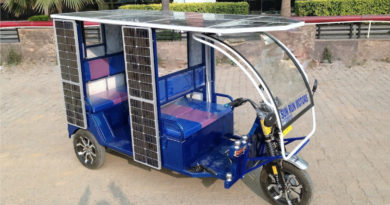A case for last mile deliveries using EVs – feat. Gati and IKEA
Electric vehicles in third party logistics (3PL) and last-mile deliveries make for a low hanging fruit when it comes to promoting EV adoption in India. In this article, we cover an EV success story that is a first in delivering small-scale cargo to customer homes and sets precedent for other businesses to form collaborations across the EV ecosystem and go electric for last mile deliveries.
Let’s get introduced with the key stakeholders in this story.
1. Business
IKEA the Swedish furniture retailer opened its first store in India at Hyderabad in August 2018. IKEA is a part of the climate group EV100 and takes its commitment towards sustainability and clean environment very seriously. With over 700,000 solar panels installed worldwide to power its stores, IKEA aims to be energy neutral by 2020, i.e. it will produce as much renewable energy as consumed by its stores. Among other initiatives, the company also intends to be 100% electric globally in terms of mobility by 2030.
At IKEA’s stores, customers can opt for home delivery option for their purchased items at an added cost. So, as the retail giant planned to open the first store in India on the outskirts of Hyderabad (Telangana), they started looking for a logistics solution to include electric fleet for home deliveries of store purchases.
2. Logistics Solutions Partner
Gati – A renowned name in the Indian logistics space, that handles more than 56 lakh packages per month. Amongst many proposals, IKEA chose Gati as its logistics partner for making last mile deliveries to customer homes. Gati is also responsible for reverse logistics and contract deliveries for IKEA in the Hyderabad region, and rest of Telangana using its hub and spoke network.
Rajeev YSR – Head of EV business at Gati; now leads Gati’s e-cargo solutions arm (AVAAN) as Chief Operating Officer. Rajeev was instrumental in setting up the EV deliveries for IKEA and BigBasket. He has provided inputs on challenges faced in setting up first of its kind delivery operations in the country.
The scale of operations at IKEA India
The Hyderabad store was opened on August 9, 2018, and saw 37 lakh visitors in its first year. Conversion in terms of customers is estimated be around 2,500 per day on weekdays and over 6,000 on weekends.
Currently, 20% of IKEA’s deliveries from its Hyderabad store are made by electric vehicles.
According to reports, that number is planned to increase to 60% in the third year of the IKEA’s operations in the city. Alongside, the company has set up the required infrastructure for EV charging in their warehouses. IKEA also plans to install charging pods at their store in Hyderabad to encourage their employees as well as customers to shift to EVs. They plan to open soon in Navi Mumbai, followed by Delhi and Bengaluru, and have started accepting e-commerce orders from customers in Mumbai, Pune and Telangana.
How Gati went about setting up deliveries through EVs
Limited range is one of the main barriers for EV adoption, however, given the nature of deliveries around a designated warehouse – last mile deliveries make an excellent use case for electric mobility.
When Gati first introduced EVs in its delivery fleet for IKEA, it came with its own set of unique challenges. Following concerns both strategic and psychological, had to be addressed to successfully set up the operations:
1. Inspiring confidence in the drivers who were accustomed to ICE vehicles and had varying degrees of confidence in the EVs
2. Load Capacity of the EV
3. Range of the electric vehicle
4. Ensuring reliability – less number of breakdowns in Hyderabad terrain rampant with slopes
To address the above concerns, the following steps were taken
1. Drivers were incentivised for EV deliveries. They were counselled and informed how they are helping the environment and saving on emissions by driving the EVs.
2. With the ICE delivery vehicles, an average round of deliveries is 8 to 9 hours long with an average run of 60 km. The area served by the EV fleet was geo-restricted to a radius of 5 km around the pick-up point, covering approx 30 km per trip to address the range and breakdown concerns. Efficient route planning was introduced to work with the changing dynamics, as the time of each delivery round reduced to 4-5 hours.
3. Charging points were set up at the IKEA store to manage the charging of the cargo vehicles.
4. Electric 3Ws and retrofitted TATA ACE vehicles were commissioned for making home deliveries to IKEA’s customers, depending on the load requirements. e-3Ws support a payload of approx 350 kg, whereas retrofitted TATA ACE can carry a payload of up to 1000 kg.
Gati has completed 15,000 – 20,000 deliveries for IKEA using electric fleet in the last 1.5 years.

Challenges and Opportunities in EV logistics
Lack of electric vehicles to replace equivalent ICE cargo vehicles, high cost, range anxiety and scarcity of charging stations are major challenges for the successful deployment of EVs. Rajeev also touched upon the requirement of having a skilled customer-facing workforce that can drive the EVs, deliver the packages and also be competent with basic English and arithmetic skills to provide the services for last mile deliveries using EVs.
When asked about the opportunities offered by EVs in the logistics space, Rajeev shared –
“We believe that in the long-term, the increase in usage of EV will result in operational savings. As for the competitive edge, EVs will have lesser restrictions in terms of entry into key metro areas compared to the conventional LCVs used in intra-city operations. Additionally, urban civic bodies across the country want to promote electric mobility through waivers in entry restrictions and taxation, etc., which means flexibility and cost efficiencies in deliveries to key urban demand points.”
Gati to focus on clean mobility for last mile deliveries
Alongside setting up EV operations for IKEA, Gati has built a solid base for offering e-logistics solutions to other businesses and counts Flipkart, Big Basket and Amazon among its clients for home deliveries via electric vehicles. The company is actively engaged with OEMs like TATA, Mahindra & Mahindra and Ashok Leyland to develop EVs that are conducive to the logistics industry, and is scouting for more electric L5 3W manufacturers to add to its 5,000 strong fleet. By 2023, Gati aspires to add 1,500 EVs and plans to leverage its spread in 600+ cities in establishing charging facilities.
“Avaan Shakti acts as an aggregator between the demand and supply of electric vehicles in the logistics industry. We aspire to make last mile deliveries organized, reliable, scalable and eco-friendly and bring all the stakeholders such as OEMs, customers & delivery partners together in this revolution.” Rajeev adds.
Subscribe & Stay Informed
Subscribe today for free and stay on top of latest developments in EV domain.







It is crucial that these delivery vehivles are charged with solar and wind power generated on site. If they are charged of India’s electrical grid they are polluting the natural environment at an alarming rate.